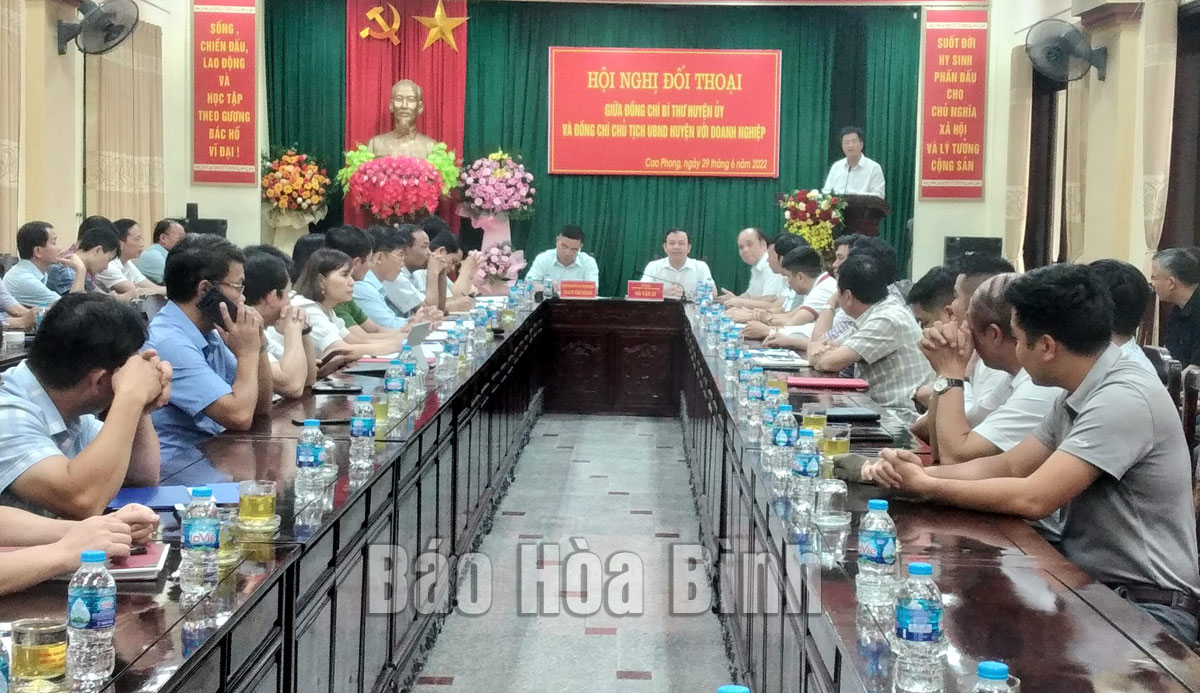
(HBO) - Cao Phong district on June 29 held a dialogue between Secretary of the district Party Committee Ha Van Di, and Chairman of the district People’s Committee Quach Van Ngoan, and representatives from the business community over investment attraction in the locality.

Delegates at the dialogue.
Ngoan briefed the participants on the district’s
socio-economic development, infrastructure, planning and investment attraction
orientations.
Cao Phong has a lot of advantages in investment
attraction, notably in high-quality agriculture, tourism and services, he said,
adding that over the past two decades, the district has developed strongly and
comprehensively.
During the development, Cao Phong has paid
attention to investment promotion, concertedly rolled out solutions to improve
its investment environment, and worked to raise its competitiveness and
facilitate the operations of businesses.
Regarding orientations, Ngoan highlighted
opportunities for Cao Phong to lure investments in urban and housing projects,
and become a satellite urban area of Hoa Binh city.
Cao Phong will optimise strengths of Binh Thanh
and Thung Nai communes, which have been included in the Hoa Binh Lake national
tourist site, according to the official.
The locality will also strive to basically
complete socio-economic infrastructure building by 2030, and promote
high-quality agriculture in combination with industry and services, he
continued.
Ngoan used the occasion to introduce 11 major
solutions to boost investment attraction in 2020-2025, with a vision towards
2030.
Many participating businesses spoke of
difficulties and obstacles to their operations, and proposed solutions to raise
the efficiency of the implementation of programmes and projects in the
locality.
On behalf of local leaders, Di committed to
further supporting businesses, investors and cooperatives, helping them remove
difficulties and improve operational efficiency.
Efforts will be made to better the local
investment environment, and create more momentum for local socio-economic
development, he said./.
According to data from the Hoa Binh Provincial Party Committee, the industrial production index for the first six months of 2025 is estimated to have increased by 20% compared to the same period last year. This marks the highest year-on-year growth rate for this period since 2020.
In the first six months of 2025, Hoa Binh province’s export turnover was estimated at 1.145 billion USD, marking an 18.11% increase compared to the same period in 2024. Import turnover was estimated at $ 804 million, a 17.15% increase, which helped the province maintain a positive trade balance.
The lives of the ethnic minority farmers in Tan Lac district have gradually improved thanks to the new directions in agricultural production. This is a testament to the collective strength fostered through the professional associations and groups implemented by various levels of the district’s Farmers’ Union.
With the motto the "product quality comes first,” after nearly one year of establishment and operation, Muong village’s Clean Food Agricultural and Commercial Cooperative, located in Cau Hamlet, Hung Son Commune (Kim Boi district), has launched reputable, high-quality agricultural products to the market that are well-received by consumers. The products such as Muong village’s pork sausage, salt-cured chicken, and salt-cured pork hocks have gradually carved out a place in the market and they are on the path to obtaining the OCOP certification.
In the past, the phrase "bumper harvest, rock-bottom prices" was a familiar refrain for Vietnamese farmers engaged in fragmented, small-scale agriculture. But today, a new spirit is emerging across rural areas of Hoa Binh province - one of collaboration, organisation, and collective economic models that provide a stable foundation for production.
Maintaining growing area codes and packing facility codes in accordance with regulations is a mandatory requirement for agricultural products to be eligible for export. Recently, the Department of Agriculture and Environment of Hoa Binh province has intensified technical supervision of designated farming areas and packing facilities to safeguard the "green passport" that enables its products to access international markets.



